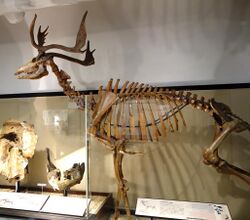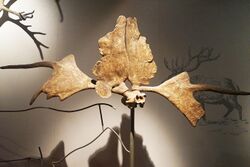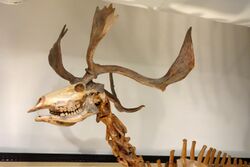Biology:Sinomegaceros
| Sinomegaceros | |
|---|---|

| |
| Sinomegaceros yabei at the National Museum of Nature and Science, Tokyo | |

| |
| Sinomegaceros pachyosteus | |
| Scientific classification | |
| Domain: | Eukaryota |
| Kingdom: | Animalia |
| Phylum: | Chordata |
| Class: | Mammalia |
| Order: | Artiodactyla |
| Family: | Cervidae |
| Subfamily: | Cervinae |
| Tribe: | Cervini |
| Genus: | †Sinomegaceros Dietrich, 1933 |
| Species | |
| |
| Synonyms | |
| |
Sinomegaceros is an extinct genus of deer known from the Early to Late Pleistocene of Central and East Asia. It is considered to be part of the group of "giant deer" (often referred to collectively as members of the tribe Megacerini), with a probable close relationship to Megaloceros. Many members of the genus are noted for their distinctive palmate antler brow tines.
Taxonomy


The first species of the genus S. ordosianus and S. pachyosteus were named by pioneering Chinese paleontologist C. C. Young as species of Cervus in 1932 for material from Zhoukoudian.[2] In a review of the paper the subsequent year Dietrich created the name Sinomegaceros as a subgenus of Cervus to house the species, with S. pachyosteus as the type species.[3] Due to the fact that the name was not published in a formal research paper, it was not widely used for several decades after publication.[4] The species S. yabei was named in 1938.[5] In the following decades various researchers considered it a subgenus of Megaloceros,[6][7] or a distinct genus.[8][9] Several named species are likely to be junior synonyms.[4] The best known species are Sinomegaceros yabei from the Middle to Late Pleistocene of Japan, alongside Sinomegaceros pachyosteus from the late Early Pleistocene to Late Pleistocene of China.
Evolution
The oldest known species in China is S. konwanlinensis from the lower Lishui Formation, around 1.1-1.15 Million years ago (Ma). S. pachyosteus appears around 1 Ma. Among the youngest known dates of S. ordosianus are around 35-50 kya in the Ordos. S. yabei first appears in the latter half of the Middle Pleistocene in Japan.[10] It has been suggested that both S. pachyosteus and S. yabei ultimately derive from S. konwanlinensis.[4] While often stated to have become extinct around 12,000 years ago, a lack of high-quality radiocarbon dates makes the time of extinction uncertain for S. yabei, with the only certain radiocarbon dates dating to around 40,000 years ago.[11]
Relationship with humans
Remains of S. yabei at Lake Nojiri in Nagano Prefecture of Honshu, Japan, dating to approximately 37,900 to 42,600 years Before Present have been found associated with spear-shaped wood pieces and large pebbles, with the long bones fractured, with their fragments bearing percussive marks, suggesting that the deer were butchered by humans at the site, with the long bones likely cracked to extract bone marrow.[12]
References
- ↑ Vislobokova, I. A. (2013). "Morphology, Taxonomy, and Phylogeny of Megacerines (Megacerini, Cervidae, Artiodactyla)" (in en). Paleontological Journal 47 (8): 833–950. doi:10.1134/S0031030113080017. ISSN 0031-0301.
- ↑ Young, C.C., 1932. On the Artiodactyla from the Sinanthropus site at Chouk’outien. Palaeontogia Sinica, Series C 8 (2), 159
- ↑ Dietrich, W.O., 1933. [Review of] C.C. Young: on the Artiodactyla from the Sinanthropus Site at Choukoutien. Neuest Jahrbuch fu ̈r Miner-alogie, Geologie und Pala ̈ontologie. Referate, III 1933(2), 475–477.
- ↑ 4.0 4.1 4.2 van der Made, J.; Tong, H.W. (March 2008). "Phylogeny of the giant deer with palmate brow tines Megaloceros from west and Sinomegaceros from east Eurasia" (in en). Quaternary International 179 (1): 135–162. doi:10.1016/j.quaint.2007.08.017. Bibcode: 2008QuInt.179..135V. http://doc.rero.ch/record/15924/files/PAL_E3331.pdf.
- ↑ Shikama, T., 1938. Discovery of giant fallow deer from the Pleistocene in Japan. Japanese Journal of Geology and Geography 16 (1–2), 115–122
- ↑ Kahlke, H.D., Hu, C.-k., 1957. On the distribution of Megaceros in China. Vertebrata PalAsiatica 1 (4), 273–283 pl. 1.
- ↑ Kahlke, R.D., 1999. The history of the origin, evolution and dispersal of the Late Pleistocene Mammuthus-Coelodonta faunal complex in Eurasia (large mammals). Mammoth site of Hot Springs, SD, inc., 219.
- ↑ Shikama, T., Tsugawa, S., 1962. Megacerid remains from Gunma Prefecture, Japan. Bulletin of the National Science Museum 6 (1), 1–13.
- ↑ Otsuka, H., Shikama, T., 1977. Studies on fossil deer of the Takao Collection (Pleistocene deer fauna in the Seto Inland Sea, West Japan— Part 1). Bulletin of the National Science Museum 3 (1), 9–40 pls. 1-6.
- ↑ Vislobokova, I. A. (December 2012). "Giant deer: Origin, evolution, role in the biosphere" (in en). Paleontological Journal 46 (7): 643–775. doi:10.1134/S0031030112070027. ISSN 0031-0301.
- ↑ Iwase, Akira; Hashizume, Jun; Izuho, Masami; Takahashi, Keiichi; Sato, Hiroyuki (March 2012). "Timing of megafaunal extinction in the late Late Pleistocene on the Japanese Archipelago" (in en). Quaternary International 255: 114–124. doi:10.1016/j.quaint.2011.03.029. Bibcode: 2012QuInt.255..114I.
- ↑ Kondo, Y.; Takeshita, Y.; Watanabe, T.; Seki, M.; Nojiri-ko Excavation Research Group (April 2018). "Geology and Quaternary environments of the Tategahana Paleolithic site in Nojiri-ko (Lake Nojiri), Nagano, central Japan" (in en). Quaternary International 471: 385–395. doi:10.1016/j.quaint.2017.12.012. Bibcode: 2018QuInt.471..385K. https://linkinghub.elsevier.com/retrieve/pii/S1040618217300307.
Wikidata ☰ Q57081337 entry

